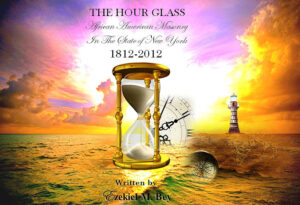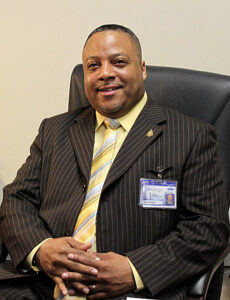The Hour Glass
African American Freemasonry In The State Of New York 1812-2012
By Ezekiel M.Bey
 A Review by: Wor. Bro. Frederic L. Milliken
A Review by: Wor. Bro. Frederic L. Milliken
Talented Prince Hall Masonic authors and writers are not as plentiful as grapes on the vine. So when one comes along we need to take notice and pay close attention to his works. Such a man is Ezekiel M. Bey whose latest book is “The Hour Glass, African American Freemasonry In The State Of New York 1812-2012.” The Hour Glass records the sands of time in the life of the Prince Hall Grand Lodge of New York, the great men therein who shaped the world to come and the part Bey has played and continues to play in the development of Prince Hall Freemasonry in New York and the nation.
Ezekiel Bey is a writer, a Historian and a poet all rolled into one. He combines that unusual dual talent of being a great researcher and historian and a great writer at the same time. Bey is no esoteric closet intellectual, however. He is a Past Master and has served on the Grand Lodge Committee on Works & Lecture, the Committee on Masonic Education where he spent some time as Secretary and the office of Grand Historian from 2006-20011. He is a Fellow of the Phylaxis Society and has spent 10 years on its Commission on Bogus Masonry much of that time as its Deputy Director. At the same time he has served as editor in chief of his Grand Lodge’s publication, The Sentinel until 2008.
One of Bey’s pride and joys is the nationwide E-Group Blue Lite which he founded. A Prince Hall discussion and educational undertaking it has blossomed into one of the most active gatherings of Masons on the Internet. Recently he has added the Prince Hall Research & Information site Blue- Lite.com.

Ezekiel M. Bey
Ezekiel Bey has paid his dues. Now all that blood, sweat and tears – that hard work and dedication and honing of skills – has culminated in a fascinating work of Masonic history, The Hour Glass.
The Hour Glass begins where every other Prince Hall Masonic book doesn’t, with the Haitian Revolution, the revolt of African American slaves from 1791-1804. The connection here is by way of Freemason Jean Pierre Boyer who was to become the second President of Haiti. Sometime during this conflict when the US and France were fighting the Franco-American War he, and all the others on his French vessel, was captured by the American war ship Trumball and brought back to Connecticut as a prisoner of war. Discovering him to be a Mason they gave him a modem of freedom and then sent him to Pennsylvania where he was ultimately set free. Boyer who attended some Lodges while he was in Pennsylvania seems to have had a profound effect on all he came in contact with as New York’s first African American Lodge, African Lodge #459 New York chartered by African Lodge #459 Boston in 1812 soon changed its name to Boyer Lodge #1. After assuming the Presidency of Haiti Boyer welcomed a migration of freed Black Americans to his country.
Bey then takes us through the Underground Railroad and the part that early New York African American Freemasons played in that historical time after which there is a detailed account of the false information that the first African American Grand Lodge in New York was Boyer Grand Lodge supposedly formed in 1845. Upon due research Bey confirms that the first African American Grand Lodge in New York was The United Grand Lodge of the State of New York formed in 1848 which later changed its name to The Most Worshipful Prince Hall Grand Lodge of the State of New York.
Next comes the painful experience of the National Grand Lodge or Compact as it was called. It was extremely stressful for New York as the United Grand Lodge of the State of New York never joined the Compact and its failure to do so resulted in the Compact attempting to expel the United Grand Lodge. Within Prince Hall Freemasonry the whole National Grand Lodge episode is a sore that will not heal. Remnants of the National Compact remain today but they are clandestine as many would say they always have been. While Mainstream Masonry also flirted with a National Grand Lodge at the same time it never pulled the trigger. Bey has contended that the whole National venture was illegal and he takes the reader through the steps of how this all came about. The documentation he provides on the history of New York African American Freemasonry at this time and New York’s involvement with the Compact is outstanding. Any historian who would like to have a better understanding of this issue should refer to The Hour Glass.
What follows is a wealth of information on clandestine African American Freemasonry in New York. Bey takes us through the Committee on Clandestine Masonry and The Legal Committee reports at Grand Lodge Sessions 1954-1969. We learn who the players are, the measures taken by the MWPHGLNY to combat bogus Freemasonry and even about a court case filed against two bogus New York Masonic Grand Lodges.
From the 1962 report of the Legal Committee to the Grand Lodge:
Litigation was commenced against two of these spurious organizations in New York State about three years ago. In November of 1961, there was a trial involving your Grand Lodge and one of these spurious organizations. In January of this year, injunctive relief was secured against this organization known as the Supreme Council of the United States of the Sovereign Grand Inspectors General of the 33rd and Last Degree A.A. Scottish Rite. This was the first case of its kind in the State of New York, in which injunctive relief was granted to a Masonic organization, giving it the right to put the spurious organization out of business. Moreover, the decision specifically stated that Prince Hall Masonry was legitimate and that it had a prior or better right to practice Masonry as against the organization which was enjoined. Your Legal Committee reports that this organization is now out of business.
Bey has continued in the footsteps of Harry A Williamson and Joseph Walkes in association with the Phylaxis Society in educating the Craft and those seeking membership about the evils of Bogus Freemasonry. This remains a continuing battle against ignorance. The Hour Glass exposes each and every one of these clandestine organizations, names names, dates and places, for all to see.
No story would be complete without heroes. Bey, in addition to his mentor Joseph Walkes, chronicles the lives and contributions to Prince Hall Freemasonry of RW Arturo Alfonso Schomburg, Harry A Williamson and S. David Bailey.
Schomburg, a native of Puerto Rico, was a promoter of Spanish speaking Lodges within Prince Hall New York. He was a researcher, historian, writer and accumulator of many Masonic books and manuscripts. In 1911 with John A. Bruce he formed the Negro Society for Research. Schomburg was elected Grand Secretary in 1918 and served in that position through 1926.
Bey tells us:
Schomburg saved every bit of information that he could get his hands on and built an archive in which he donated to public libraries. He is the reason that today Freemasonry and the black struggle in America have a huge section in the New York City Public Library in Harlem. This spirit of saving information for our future influenced his good friend and Brother, R.W. Harry A. Williamson, Grand Historian of the Most Worshipful Prince Hall Grand Lodge of New York. It was Arthur Schomburg who encouraged Williamson to place his collection of over 800 books, manuscripts, photographs, periodicals, pamphlets, and scrapbooks in the N.Y.C. Public Library’s Division of Negro Literature, History and Prints.
By the year 1925, Schomburg had acquired over 5,000 books, pamphlets, manuscripts, etchings and many other items. When the Division of Negro Literature opened in the New York City Public Library on 135th Street in Harlem, Schomburg sold his collection for $10,000 to the Carnegie Corporation to be placed in the new library. Schomburg later became curator for the library in 1932 in the Division of Negro Literature, History and Prints. In memory of Arturo Alfonso Schomburg, the New York City Public Library in Harlem was renamed in 1973, “The Schomburg Center for Research in Black Culture”.
Another giant of Prince Hall New York that Bey writes about was Harry A Williamson. Grand Historian from 1911 through 1924 Williamson held many Grand Lodge offices including Senior Grand Warden and Deputy Grand Master and chaired many Grand Lodge Committees. He was a prolific writer and was an early crusader against Bogus Freemasonry in the state of New York.
The third legend from Prince Hall New York was S. David Bailey an accomplished jazz percussionist. Bey tells us that he had:
collaborations with most of the Ellington Alumni, such as Mercer Ellington, Billy Strayhorn, Ben Webster, “Shorty” Baker, and Al Sears. David Bailey also played with Billy Taylor, Clark Terry, Bob Brookmeyer, Miles Davis, Chris Conner, Billie Holiday, Marian McPartland, Lucky Thompson, Lena Horn, Harry Bellefonte and the Gerry Mulligan Band(s) for 13 years until 1968 when he left to join the newly formed “Jazztet” featuring Art Farmer, Benny Golson,
But Bailey had another love – flying. Again we learn from Bey:
From 1968 to 1973, David worked with famed criminal attorney F. Lee Bailey as Vice President of Marshfield Aviation in Marshfield Airport, Massachusetts, 20 miles south of Boston. As Chief Pilot and flight instructor, and the attorney’s personal pilot, David flew the business Learjet in and out of Logan International Airport in Boston. Dave was also a Designated Pilot Examiner for the FAA in Boston as he was in New York. David enjoyed a good professional relationship and warm friendship with F. Lee Bailey.
But in a strange twist of career paths Bailey returned to his first love when he became Executive Director of Jazzmobile.
In Prince Hall Freemasonry Bailey became a District Deputy and his efforts in Masonic Instruction and Masonic Education became renowned. He headed up the first Grand Lodge Committee on Education and now 86 years old he can look back upon an illustrious Masonic career of 60 years.
It is difficult to know where you are going unless you know where you have been. The Hour Glass will prove to be a most valuable work for Prince Hall New York Masons to remember where they have been and to honor and treasure the memories of those who have gone before them.
It is vitally imperative that within the Craft records and archives are kept to show a clear path of what Freemasonry has stood for and what it has withstood throughout its history. Ezekiel Bey has been meticulous and detailed in his research for this book. The Hour Glass is both interesting and informative.
Not shy in expressing himself, Bey writes with a passion that jumps out at you from the pages of his book. His love for the Craft comes through loud and clear.
Moreover, Bey blazes a trail that other Prince Hall Grand Lodges should take. A chronicling of the history of any Grand Lodge casts in stone what defines that Masonic community and it is by such a work as this that a Grand Lodge can tackle the future with a mission statement in hand.
This is a monumental work that will be on every library shelf and in many a Mason’s bookcase. It should be in yours also.

Bro. Fred,
What a great review, I can’t wait to read this now. Thank you for bringing it to my attention.